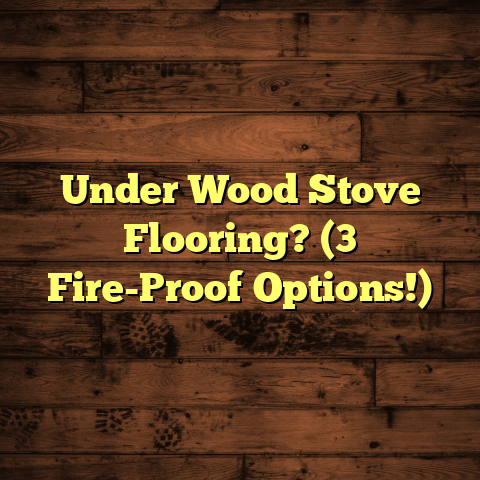Use Cement Board On Floors? (6 Things to Know!)
Upgrading your floors isn’t just about aesthetics; it’s about boosting your home’s value and making your everyday life a little more comfortable.
Think about it: a fresh, durable floor can
completely transform a room, making it feel
more modern, spacious, and inviting.
And in today’s world, where durability and
moisture resistance are king, homeowners are
constantly searching for materials that can
stand the test of time and the rigors of daily life.
That’s where cement board comes in.
It’s a popular choice for creating a
long-lasting and stable base, especially
for tile and stone flooring.
But before you jump on the cement
board bandwagon, there are a few key
things you should know.
I’ve spent years installing and working
with different flooring materials, and
I’ve learned a thing or two about what
works and what doesn’t.
So, let’s dive into the six essential
points you need to consider when deciding
whether to use cement board on your floors.
I’m here to help you make an informed
decision and ensure your next flooring
project is a resounding success!
Section 1: What is Cement Board?
Alright, let’s get down to basics.
What exactly is cement board?
Well, think of it as a super-tough,
moisture-resistant panel made from a
mixture of cement, sand, and reinforcing fibers.
It’s kind of like concrete, but in sheet form.
The cement acts as a binder, holding everything
together, while the sand adds bulk and
strength.
The reinforcing fibers, often fiberglass,
give the board extra flexibility and prevent
it from cracking easily.
Cement board is primarily used in
construction as an underlayment, especially
for tile and stone flooring.
You’ll often find it in bathrooms, kitchens,
and other areas prone to moisture.
I’ve even used it in some pretty creative
outdoor applications, but more on that later.
Now, why choose cement board over traditional
materials like plywood or particleboard?
The answer is simple: moisture resistance.
Plywood and particleboard are basically sponges
when it comes to water.
They can warp, swell, and even rot if exposed
to moisture for too long.
Cement board, on the other hand, is virtually
impervious to water damage.
It won’t warp, rot, or promote mold growth,
making it a far superior choice for wet areas.
Plus, cement board is incredibly durable.
It can withstand heavy loads and resist
impact damage, ensuring your flooring stays
stable and secure for years to come.
According to the Tile Council of North
America (TCNA), cement board underlayment
is recommended for tile installations in
wet areas to prevent moisture-related issues.
There are also different types of cement
boards available on the market.
The most common variation is thickness.
You’ll typically find cement board in
1/4-inch, 1/2-inch, and 5/8-inch thicknesses.
The thickness you choose will depend on the
specific application and the type of flooring
you’re installing.
For example, a thinner 1/4-inch board might be suitable for walls or areas with less foot traffic, while a thicker 1/2-inch or 5/8-inch board is recommended for floors that need extra support and durability.
There are also specialty cement boards
designed for specific purposes, such as
lightweight boards for easier handling or
boards with enhanced mold resistance for
extremely humid environments.
I always recommend doing your research and
choosing the right type of cement board
for your particular needs.
Section 2: Why Use Cement Board on Floors?
So, we know what cement board is, but
why should you actually use it on your floors?
Well, as I mentioned earlier, the biggest
advantage is its incredible moisture resistance.
But there’s so much more to it than that.
Let’s break down the key benefits in detail:
Moisture Resistance: This is the big one.
Cement board is ideal for high-moisture areas like bathrooms, kitchens, and laundry rooms.
Unlike wood-based underlayments, it won’t absorb water, swell, or rot, even if exposed to spills or leaks.
I’ve seen countless bathrooms where plywood subfloors have been completely destroyed by water damage, leading to costly repairs.
With cement board, you can say goodbye to those worries.Stability and Durability: Cement board is incredibly strong and stable.
It can withstand heavy loads without cracking or warping over time.
This is especially important for tile and stone flooring, which can be prone to cracking if the underlying surface is not stable.
I’ve used cement board in commercial kitchens and high-traffic areas, and it has consistently performed flawlessly.Ease of Installation: While it might seem intimidating at first, cement board is actually quite easy to install.
It can be cut with a utility knife or circular saw, and it’s relatively lightweight, making it easier to handle than concrete.
Plus, it provides a smooth, even surface for tiling, which can simplify the installation process and save you time and effort.Cost-Effectiveness: Okay, I know what you’re thinking: “Cement board is probably expensive, right?” Well, not necessarily.
While the initial cost might be slightly higher than plywood, the long-term savings can be significant.
Because cement board is so durable and resistant to moisture damage, it requires less maintenance and is less likely to need replacement.
Over time, this can save you a considerable amount of money.
To illustrate this, let’s look at a real-life example.
I once worked on a bathroom renovation where
the homeowner was hesitant to use cement board
because of the initial cost.
They opted for a cheaper plywood underlayment instead.
Fast forward two years, and a small leak under
the toilet had completely ruined the plywood,
requiring a full replacement of the subfloor
and the tile.
The cost of the repair was significantly higher
than the initial cost of using cement board would
have been.
This is a classic example of how “penny-wise,
pound-foolish” decisions can backfire in the long run.
I’ve also spoken to numerous builders who swear
by cement board.
One contractor I know, Mark, told me he
exclusively uses cement board in all his
bathroom and kitchen projects.
He says it’s simply not worth the risk of
using anything else, given the potential
for water damage.
He’s never had a callback due to flooring
issues since he started using cement board,
which speaks volumes about its reliability.
Section 3: Preparing the Subfloor
Alright, you’re convinced that cement board
is the way to go.
Great!
But before you start slapping those
boards down, you need to make sure your
subfloor is properly prepared.
This is a crucial step that can make or break
your entire flooring project.
Here’s what you need to do:
Assessing the Existing Floor: First, you need to inspect the existing subfloor for any signs of damage, such as rot, cracks, or unevenness.
Use a level to check for any dips or humps.
If you find any problems, you’ll need to repair them before proceeding.
This might involve replacing damaged sections of the subfloor or using a leveling compound to create a smooth, even surface.Cleaning and Moisture Testing: Next, thoroughly clean the subfloor to remove any dirt, dust, or debris.
You can use a broom, vacuum cleaner, or even a damp mop.
Once the subfloor is clean, it’s important to test for moisture.
You can use a moisture meter to check the moisture content of the wood.
Ideally, the moisture content should be below 12%.
If it’s higher than that, you’ll need to allow the subfloor to dry out completely before installing the cement board.Choosing the Right Tools and Materials: Now, let’s talk tools.
You’ll need a few essential items for installing cement board, including:- Utility knife or circular saw with a cement board blade
- Measuring tape
- Pencil
- Drill or impact driver
- Cement board screws
- Thin-set mortar
- Seam tape
- Safety glasses
- Dust mask
Safety Precautions: Speaking of safety, it’s important to wear protective gear during the installation process.
Cement board dust can be irritating to the skin and lungs, so always wear safety glasses and a dust mask.
You should also wear gloves to protect your hands from the sharp edges of the cement board.
Here’s a step-by-step guide to preparing the subfloor:
- Remove any existing flooring: This includes carpet, tile, vinyl, or any other floor covering.
- Inspect the subfloor for damage: Look for signs of rot, cracks, or unevenness.
- Repair any damage: Replace damaged sections of the subfloor or use a leveling compound to create a smooth, even surface.
- Clean the subfloor: Remove any dirt, dust, or debris.
- Test for moisture: Ensure the moisture content is below 12%.
- Gather your tools and materials: Make sure you have everything you need before you start.
- Put on your safety gear: Protect your eyes, lungs, and hands.
By following these steps, you’ll ensure that your subfloor is properly prepared for the installation of cement board.
This will help to create a stable, durable, and moisture-resistant foundation for your new flooring.
Section 4: Installation Process
Alright, the subfloor is prepped, and you’re
ready to roll.
Now comes the fun part: actually installing
the cement board.
Don’t worry, it’s not as daunting as it might seem.
I’m going to break it down into clear,
actionable steps to make the process as smooth
as possible.
Measuring and Cutting the Cement Board: The first step is to measure the area where you’ll be installing the cement board.
Use a measuring tape and pencil to mark the dimensions on the board.
When cutting cement board, you have two main options: a utility knife or a circular saw.-
Utility Knife: Score the board along the marked line several times with a utility knife, then snap the board along the score line.
This method is best for straight cuts and smaller pieces. -
Circular Saw: Use a circular saw with a cement board blade to make clean, precise cuts.
Be sure to wear safety glasses and a dust mask when using a circular saw, as it will create a lot of dust.
Remember to always cut the cement board slightly smaller than the actual dimensions of the area to allow for expansion and contraction.
I usually leave a 1/8-inch gap around the perimeter of the room.-
Securing the Board to the Subfloor: Once you’ve cut the cement board to size, it’s time to secure it to the subfloor.
Apply a layer of thin-set mortar to the subfloor using a notched trowel.
The thin-set will help to create a strong bond between the cement board and the subfloor.Place the cement board on top of the thin-set and press down firmly.
Use cement board screws to fasten the board to the subfloor.
The screws should be long enough to penetrate the subfloor by at least 1 inch.
Space the screws every 6-8 inches along the edges of the board and every 8-12 inches in the field.It’s important to use cement board screws specifically designed for this purpose.
Regular screws can corrode or break, compromising the integrity of the installation.Sealing Joints and Edges: After the cement board is secured, you need to seal the joints and edges to create a waterproof barrier.
There are two main methods for sealing joints:- Thin-Set Mortar: Apply a layer of thin-set mortar to the joints and edges, then embed seam tape into the mortar.
Use a putty knife to smooth out the mortar and remove any excess. - Seam Tape: Apply seam tape directly to the joints and edges, then cover the tape with a layer of thin-set mortar.
Both methods are effective, but I personally prefer using thin-set mortar and seam tape for added protection.
- Thin-Set Mortar: Apply a layer of thin-set mortar to the joints and edges, then embed seam tape into the mortar.
Finishing Touches: Once the joints and edges are sealed, allow the thin-set mortar to dry completely according to the manufacturer’s instructions.
This usually takes 24-48 hours.
After the mortar is dry, you can prepare the surface for tiling or other flooring materials.If you’re installing tile, you’ll need to apply another layer of thin-set mortar to the cement board and then set the tiles in place.
If you’re installing another type of flooring, you may need to apply a self-leveling compound to create a perfectly smooth surface.
Here’s a quick recap of the installation process:
- Measure and cut the cement board.
- Apply thin-set mortar to the subfloor.
- Secure the cement board to the subfloor with screws.
- Seal the joints and edges with thin-set mortar and seam tape.
- Allow the mortar to dry completely.
- Prepare the surface for tiling or other flooring materials.
With a little patience and attention to detail, you can successfully install cement board flooring and create a durable, moisture-resistant foundation for your new floors.
Section 5: Maintenance and Care
Okay, you’ve installed your cement board flooring,
and it looks fantastic!
But the job’s not quite done yet.
To ensure your flooring stays in top condition
for years to come, you need to follow a few
simple maintenance and care tips.
Cleaning Techniques: When it comes to cleaning cement board flooring, less is often more.
Avoid using harsh chemicals or abrasive cleaners, as these can damage the surface.
Instead, opt for a mild detergent and warm water.Use a soft mop or cloth to clean the floor, and be sure to rinse thoroughly to remove any soap residue.
For stubborn stains, you can try using a solution of baking soda and water.I always recommend testing any cleaning product in an inconspicuous area first to make sure it doesn’t damage the flooring.
Inspecting for Issues: Regularly inspect your cement board flooring for any signs of wear or damage.
Look for cracks, chips, or loose tiles.
If you find any problems, address them immediately to prevent them from getting worse.Small cracks can be filled with a cement-based patching compound.
Loose tiles can be reattached with thin-set mortar.
If you’re not comfortable making these repairs yourself, it’s best to call a professional.Long-term Care: To ensure the longevity of your cement board underlayment, it’s important to avoid excessive moisture exposure.
While cement board is moisture-resistant, it’s not completely waterproof.
Prolonged exposure to water can still cause damage over time.Make sure to clean up any spills or leaks immediately.
Use bath mats and shower curtains in bathrooms to prevent water from splashing onto the floor.
And ensure good ventilation in high-moisture areas to help prevent mold growth.
Here are a few additional tips for long-term care:
- Avoid dragging heavy objects across the floor. This can scratch or damage the surface.
- Use furniture pads under the legs of chairs and tables. This will help to prevent scratches and dents.
- Consider applying a sealant to the cement board. This will provide an extra layer of protection against moisture and stains.
By following these maintenance and care tips, you can keep your cement board flooring looking its best for years to come.
Section 6: Common Misconceptions and FAQs
Alright, let’s tackle some common misconceptions
and frequently asked questions about using
cement board on floors.
I’ve heard it all over the years, so let’s
set the record straight.
Is cement board too heavy for residential use? This is a common concern, but it’s generally not an issue.
While cement board is heavier than plywood, it’s not excessively heavy.
A standard 3×5 foot sheet of 1/2-inch cement board weighs around 40-50 pounds.
Most residential floors can easily support this weight.
However, if you have any concerns about the structural integrity of your floor, it’s always best to consult with a structural engineer.Can cement board be used in outdoor settings? Yes, cement board can be used in some outdoor settings, but it’s important to choose the right type of board and follow proper installation procedures.
Look for cement boards specifically designed for exterior use, and make sure to seal all joints and edges with a waterproof sealant.
I’ve used cement board for outdoor kitchens and patios with great success.How does cement board compare to other underlayment options? There are several other underlayment options available, such as plywood, backer board, and self-leveling compounds.
Each material has its own advantages and disadvantages.
Plywood is a cheaper option, but it’s not moisture-resistant.
Backer board is similar to cement board, but it’s typically thinner and less durable.
Self-leveling compounds are great for creating a perfectly smooth surface, but they can be expensive.
In my opinion, cement board offers the best combination of durability, moisture resistance, and cost-effectiveness for most flooring applications.
Here are a few other frequently asked questions:
Can I install cement board over existing flooring? It’s generally not recommended to install cement board over existing flooring.
The existing flooring can create an uneven surface and prevent the cement board from bonding properly to the subfloor.
It’s always best to remove the existing flooring and install the cement board directly on the subfloor.Do I need to use thin-set mortar when installing cement board? Yes, thin-set mortar is essential for creating a strong bond between the cement board and the subfloor.
It also helps to prevent moisture from seeping underneath the board.Can I paint cement board? Yes, you can paint cement board, but it’s important to use a primer specifically designed for masonry surfaces.
This will help the paint to adhere properly and prevent it from peeling or flaking.
I hope this clears up some of the common misconceptions and answers your questions about using cement board on floors.
If you have any other questions, feel free to ask!
Conclusion
So, there you have it!
We’ve covered the six essential things you need
to know about using cement board on floors.
From understanding what cement board is and
why it’s so great, to preparing the subfloor,
installing the boards, maintaining them, and
addressing common misconceptions, you’re now
well-equipped to make an informed decision
about your next flooring project.
I’ve shared my experiences and insights
from years of working with this versatile
material, and I hope it’s been helpful.
Remember, the key benefits of using cement
board include its incredible moisture
resistance, stability, durability, and
long-term cost-effectiveness.
Whether you’re renovating a bathroom,
kitchen, or any other area prone to moisture,
cement board is definitely worth considering.
Just make sure you understand the installation
process and maintenance requirements to ensure
your flooring remains beautiful and functional
for years to come.
I encourage you to explore cement board as a
viable option for your next home improvement
project.
With the right preparation, installation,
and care, you can create a stunning and
long-lasting floor that will enhance the
beauty and value of your home.
Thanks for joining me on this flooring adventure! Happy renovating!





